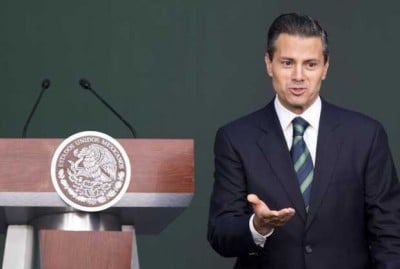Thousands of Mexican Workers and Youth Demand Peña Nieto’s Resignation

Tens of thousands of workers and youth marched in 60 Mexican cities on December 1 to protest the disappearance of 43 Ayotzinapa student teachers in the city of Iguala, in the southern State of Guerrero. The marchers are demanding that the 43 be returned alive and the resignation of Mexico’s President Enrique Peña Nieto. The protest took place alongside student strikes in dozens of universities. December 1 also marked the second anniversary of Peña Nieto’s presidency.
In Mexico City the protest began at about 3 p.m. in the city’s historic central square, the Zocalo. On reaching the Angel of Independence monument on Paseo de la Reforma, two columns broke off, north and south along that very wide historic boulevard. At 9 p.m. groups were still arriving at the Angel of Independence monument.
Marchers carried signs in solidarity with the 43 disappeared students, many of them homemade. “I am marching today so I will not have to march for my children tomorrow!” said one sign. Others carried signs demanding the president’s resignation. “We are sick and tired of this government,” was a popular chant along the route of the march.
Heading the demonstration out of the Zocalo were parents of the disappeared students. At the rally at the Angel of Independence, many parents spoke movingly about their sadness and uncertainty, wondering if their children are even still alive. One of the speakers, Clemente Rodriguez, whose son Christian is among the missing, revealed that Guerrero’s governor, Ángel Aquirre (who recently resigned his post), had tried to buy his silence by offering him and his family a substantial sum of money that they refused.
Students from the National Polytechnic Institute (IPN), one of the largest public universities in Mexico, also spoke and read a statement calling not just for Peña’s resignation, but that of the entire government.
Observers from the UN and National Human Rights Commission (CNDH) monitored the march.
As the protest was ending, the CNDH observers aggressively intervened and formed a human chain to protect some 500 demonstrators across from the Congress building from hundreds of police and escort them to the Hidalgo subway (Metro) station that had been closed by the police and Metro officials. The CNDH negotiated with the police to reopen access to the station and help limit the police repression. Demonstrators entered the station in groups of 20 escorted by the CNDH.
The police operation was suspiciously similar to the police assault of demonstrators on November 20. On that day, a group of agents provocateurs had created an incident that gave the police an excuse to attack the demonstration, terrorizing and conducting random arrests.
While on Monday, a group of provocateurs did break store windows and pour red paint on ATMs, the protesters themselves chased many of these individuals away, calling them “fascists,” “porros” (strikebreakers), Peña thugs and provocateurs, while others chanted “no violence, no violence.”
The police had shuttered several of the downtown Metro stations, supposedly for passenger safety, effectively creating a corridor to herd fleeing demonstrators if the riot-equipped force of between 500 and 700 police had had its way.
In addition to the student youth, many workers joined the march, including contingents from the National Coordination Committee of Education Workers (CNTE), the Mexican Electrical Workers Union (SME) and unions representing university workers from the National Autonomous University (UNAM), Metropolitan Autonomous University (UAM) and IPN. Thousands of workers participated in the protest, independent of their unions. The bulk of the trade union bureaucracy supports Peña Nieto and the ruling party, the Revolutionary Institutionalist Party (PRI).
The CNTE announced plans for a mass mobilization of education workers on December 6, for a symbolic takeover of Mexico City.
Thousands protested in others cities. In Guadalajara, the country’s third largest city, the day of protest coincided with the International Book Fair (FIL), a yearly event. Writers led the protest march, including Chilean author José Donoso, and Juan Viloro, from Mexico.
In Oaxaca, 1500 teachers and students blocked the road to the airport for four hours. Several flights were cancelled.
Marchers in Chilpancingo, Guerrero’s capital, also denounced the Peña government. “We no longer recognize Enrique Peña Nieto as president of Mexico because he has not addressed our central demand, that our children be returned alive,” said family member Felipe Cruz.
The loss of legitimacy for the Peña government is now widespread. A poll by the Mexican daily Reforma indicates plummeting popularity for the president. His approval rating is now 39 percent, down from 46 percent in August of this year, one of the lowest ratings for any president in Mexican history. Federal authorities have lost legitimacy in many areas, where military and drug cartels are in control. In a public appearance in Chiapas, Peña himself acknowledged as much: “What took place in Iguala represents a before and after … It demonstrates the weakness of the government to confront organized crime, which has more weapons and more fighting capacity than in the past,” he said.
The wave of protest marches, road barricades and mobilizations, both on November 20 and on December 1, represents an important qualitative change that poses the question of who is to rule Mexico.
For workers to repudiate the president, the PRI (or the entire political establishment for that matter) is insufficient. None of the political parties or pseudo-left currents, from the crisis-ridden PRI and PRD (Democratic Revolutionary Party) to Andrés Lopez Obrador’s MORENA stands for the interests of the working class or youth. Whatever tactical differences they may have with each other, they are united on one strategy, that of preserving capitalism in Mexico.
Only one force, the working class, is capable of providing a way forward against the capitalist cabal of criminal syndicates, out and out corrupt institutions, and predatory foreign banks and investors.

